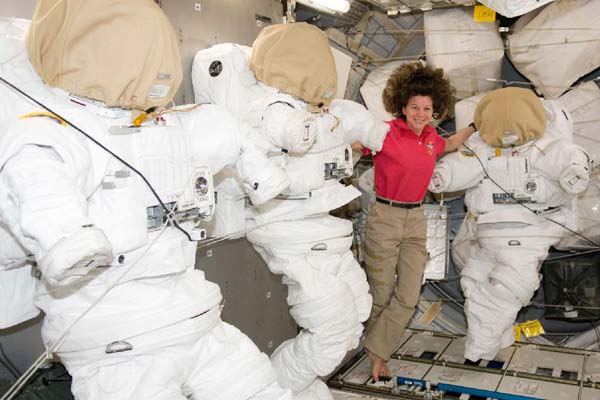
Life in orbit: tales from the International Space Station
Published: January 11, 2013
Reception was surprisingly good on the phone call from space.
“We just flew across Canada,” said Commander Chris Hadfield, speaking from the International Space Station.
“It took about seven minutes.”
His voice travelled from the reaches of earth’s orbit to astronaut Catherine Coleman’s mobile, held up to a microphone before a packed hall of University of Toronto students and faculty.
An astronaut with the National Aeronautics and Space Administration (NASA), Coleman was at U of T Jan. 9 to deliver the latest talk in the Lectures on the Leading Edge (LLE) series hosted by the department of Chemical Engineering & Applied Chemistry. She called in a favour with her long-time friend and colleague Hadfield to connect her audience with the realities of science in space in the most immediate of ways.
“Our labs are humming up here,” said Hadfield, explaining that about 100 separate experiments are currently under way.
After the brief call ended, Coleman shared her own stories and experiences from three trips, and more than 180 days, in space. Though Coleman was a part of two space shuttle missions (1995, 1999) her talk focused on the six months she spent on the International Space Station (ISS) starting in December of 2010, as well as how the facility offers opportunities for scientists at the University of Toronto.
“Being an astronaut is not just about going to space, it’s about being eyes and ears,” said Coleman, “it’s about representing the human point of view. Because more than just the actual stuff that gets done up there, we are part of a team that explores."
Coleman described some of the numerous experiments on board the space station – such as using blood pressure readings from space to predict fainting and analyzing bone metabolism to further osteoporosis research. As the mission’s lead science officer, Coleman led more than 150 different investigations.
“In science and engineering we address critical societal questions,” said Professor Molly Shoichet of the Department of Chemical Engineering & Applied Chemistry and the Institute of Biomaterials and Biomedical Engineering. “The purpose of LLE is to shed light on new ideas and ways of thought. Catherine’s lecture did exactly that. She inspired members of our audience to tap into their hidden potential.”
Coleman also highlighted Canadian contributions to the ISS, and encouraged students and researchers to submit proposals for experiments on the station.
“It used to be that the time from idea to experiment in space was 10 years,” she said. “But now the Space Station is open for business.”
Through a multimedia presentation, Coleman shared much about the daily realities of life on the ISS, such as using a toilet in zero gravity (demonstrated in a curious video showing the toilet vacuum away colourful candies), sleeping in a pod, getting from one end of the station to the other—“you’re not going to float, you’re going to fly” she said, showing video of herself shooting from one side of a lab to the other— and playing a flute duet with musician Ian Anderson of Jethro Tull, who was back on Earth.
Coleman also spoke about the emotional stakes, such as how desperate the astronauts all are for maximum spacewalk time: robotic elements now perform many duties outside the station, “which, from the astronaut’s point of view, disappoints us greatly,” she said, laughing. But that didn’t seem to sour her experience.
“I think I had that smile on my face form the time I got there ‘til the time I left,” she said, “and I would spend another six months there in a minute.” That’s even though she described re-entry to earth as being “like going over Niagara Falls in a barrel, on fire, and then being hit by a Mack truck.”
Coleman’s enthusiasm was matched by members of the audience.
“It’s not every day you get to hear a NASA astronaut speak – that’s why I came to today’s lecture,” said Jeffrey Castrucci, a PhD Candidate in the Department of Chemical Engineering & Applied Chemistry. “Learning how Catherine’s pure passion for science brought her great success was truly inspirational.”
For more information about future LLE lecturers visit here.



